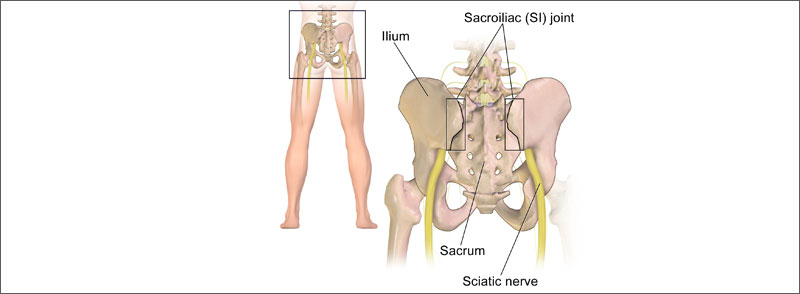
Sacroiliac joint dysfunction is a term used to describe the pain of the sacroiliac joint (SI joint). It is usually caused by abnormal motion (i.e. hyper- or hypo-mobile) or malalignment of the sacroiliac joint. Sacroiliac joint syndrome is a significant source of pain in 15% to 30% of people with mechanical low back pain.
Sacroiliitis is not the same as SI joint dysfunction. Sacroiliitis is specific to an inflammatory processes present in the SI joint and the pain sensed is a direct result of those inflammatory processes, whereas sacroiliac joint dysfunction is a condition caused by abnormal motion or slight mispositioning of the SI joint.
Sacroiliac joint syndrome is a condition that is difficult to diagnose and is often overlooked by physicians and physiotherapists.
Clinically Relevant Anatomy
The sacroiliac joints are located on each side of the spine between the two pelvic bones, which attach to the sacrum. The main function within the pelvic girdle is to provide shock absorption for the spine and to transmit forces between the upper body and the lower limbs. The SI joint experiences forces of shearing, torsion, rotation, and tension. Ambulation is heavily impacted by the SI joint, as this is the only orthopedic joint connecting the upper body to our lower body. The joint is a relatively stiff synovial joint filled with synovial fluid. The bones of the sacrum and ilium are coated in hyaline cartilage at their articular surfaces with dense fibrous tissue connecting the ilium and the sacrum. SI joints typically only have a few degrees of motion
Etiology
Injuries to the sacroiliac joint can occur from various etiologies.
- 88% of cases of SI joint injury are due to either repetitive microtrauma or acute trauma. There is a high prevalence of SI joint injury in athletes. Trauma in the context of pelvic ring injuries is one example of SI joint injury. Pelvic ring traumatic injuries and low impact Pelvic fractures can be read about here.
- 20% of cases are pregnancy-related. Female hormones are released during pregnancy, relaxing the sacroiliac ligaments. This stretching in ligaments results in changes to the sacroiliac joints, making them hypermobile.[3] After the fifth decade of life, the sacroiliac joint fuses
- 4% are idiopathic.
- Pain can also be caused by an abnormality of the sacrum bone, which can be seen on X-rays.
Epidemiology
Approximately 90% of the population will at some experience or present to the clinic with some form of low back pain/pathology. About 10% to 25% of these patients are thought to be experiencing pain from the SI joint. The majority of SI joint pathologies affect the adult patient population.
- The majority of individuals affected by sacroiliac joint pain are adults. The disorder is most common in individuals who lead a sedentary lifestyle.
- Overall, obese patients are more commonly affected by sacroiliac joint pain.
- The disorder is seen in both genders and people of all races.
